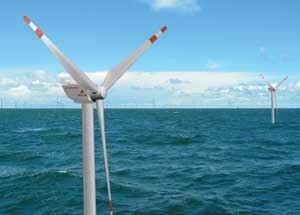 From Oil Sector to Wind Power in NorwayApr 14, 2010 - Claude R. Olsen - The Research Council of Norway
Eying the vast potential for establishing wind farms at sea, companies along Norway's west coast are making the leap from offshore oil to offshore wind power. Developing offshore wind power could prove just as profitable as petroleum industry projects, and the potential for value creation is enormous. Statoil and Statkraft, Norway's heavyweight energy companies, recognize this potential and have already secured a key position in Great Britain, where the development of wind power is highly subsidized. The two Norwegian companies, together with the energy companies Scottish and Southern Energy and RWE npower, will develop Dogger Bank, by far the largest British wind power project to date. Other Norwegian companies are also getting in line to compete for contracts for large development projects for offshore wind farms. More than 40 companies primarily from Hordaland and Rogaland counties have joined the Arena NOW (Norwegian Offshore Wind) network. Every member company has experience in the oil and gas industry; some have already landed their first wind power contracts and completed their first installations. “This surge toward wind power will bring some profound changes to this region’s industrial makeup,” says Yngve Aabø, Chairman of Arena NOW. German Wind Farm Draws on Norwegian Expertise The German wind farm Alpha Ventus, located off Germany’s northwest coast, has drawn upon Norwegian technology and expertise for the production and installation of wind turbine foundations. Bergen-based OWEC Tower and Trøndelag-based Aker Solutions Verdal have supplied steel structures for six foundations each. Another Bergen company, NorWind, installed the OWEC foundations. From Powering Platforms to Power Systems for Wind Farms Troll Power, another Bergen company, currently supplies power to the petroleum industry. Its new company Troll WindPower, together with wind power supplier NorWind, is now gearing up to supply power systems for offshore wind farms. At the Bergen Group Rosenberg shipyard in Stavanger, the first modules for a power station designed exclusively for wind farms will soon be completed. Troll Power has developed a tool to detect risks in the power grid when various energy producers and users are connected to the grid. This new tool will be very valuable to grid operators and energy companies as more and more wind farms go online. “It would not have been possible to establish Troll Power and Troll WindPower without funding from the Research Council and Innovation Norway,” says Mr Aabø, CEO of both companies as well as chairman of the Arena NOW network board. Sway AS, located south of Bergen, is a worldwide leader in floating wind turbines. The company has developed a floating wind turbine that can be placed anywhere the sea is deeper than 30 metres. Most of Sway’s 20 employees were recruited from the petroleum sector. Indeed, many others from this sector are intrigued by the prospect of applying their offshore expertise to the dynamic field of renewable energy and helping to drive its progress at Sway and similar companies. The engineers at Sway are confident in their wind turbine design, which uses an unconventional setup by placing the rotor behind the nacelle. As the floating tower leans some 6-8 degrees away from the wind, this downwind design allows the unit to tilt forward — keeping the blades aligned with the wind’s force to capture its maximal energy. Sway collaborates with German wind turbine manufacturer Multibrid, which has specially developed this innovative turbine. The first full-scale Sway turbine is expected to launch in 2011, most likely in Spain. “Our goal is to harness offshore wind energy without public subsidies some day,” says Michael Forland, CFO of Sway. He estimates that this could be the case within a decade. Claude R. Olsen is a writer at The Research Council of Norway. This article was translated from Norwegian by Darren McKellep and Carol B. Eckmann.
|
Email this page to a friend
If you speak another language fluently and you liked this page, make
a contribution by translating
it! For additional translations check out FreeTranslation.com
(Voor vertaling van Engels tot Nederlands)
(For oversettelse fra Engelsk til Norsk)
(Для дополнительных
переводов проверяют
FreeTranslation.com )


